UCLA Phonetics LabELECTROPALATOGRAPHY (EPG) |
The Phonetics Lab acquired its Kay Palatometer Model 6300 in 1992, with a dissertation improvement grant to Dani Byrd, and much use was made of it. While it is still in the lab, it has not been used in years: a DOS program limited to a low sampling rate (12.8 kHz for the audio, 100 Hz for the EPG), it requires an older type of PC with two full-size slots for the Palatometer and CSL boards. The instructions below are kept available for historical purposes.
I. Basic Experimental Steps to Follow
II. How we normally analyze the data
- Get a grant (or inherit money)
- Human subject approval
- Custom pseudo-palate
- Get used to pseudo-palate
- Do the experiment
- Analyze the data
III. Displaying Palatometer in 3D
- Obtain 'Percent.exe' software which is in Frida
- Create a .DEF file
- Create a .BAT (batch) file
- Do batch processing
- Make a configuration (.cfg) for CSL
- Analyze the data using CSL
IV. Some results: Domain-initial strengthening
- French
- Korean
1. Get used to pseudo-palate.
We usually have our speaker wear his or her pseudo-palate to get used to it; the more the better, but usually for an hour of normal activity to accommodate and diminish any salivation response (Byrd et al. 1995).
2. Do the experiment.
- For recording, we need two pieces of hardware, CSL (for audio) and the Palatometer, at the same time, which is the normal setup on Jasmine now in the Physiology Lab (2101E).
- Detailed procedures of data collection:
- Have your subject wear his/her pseudo-palate.
- Turn off the Palatometer, attach a grounding electrode to the speaker (which can be found in 2101P, the 'cool' room), connect the pseudo-palate to the Palatometer, and turn on the Palatometer.
- When ready to collect the data, run "pal.exe" (by typing "pal" - you don't have to be in the directory where the program is, which is also "pal"), and do three steps under the 'setup' menu on the screen:
(1) choose the number of users
(2) choose a user name (a user file such as PKEATNG1.USR, THCHO.USR) for each user (back-ups of these files are on a disk kept near the computer, and Pat and Henry both have copies);
(3) check the sensitivity, by turning the small knob while subject talks until the peak value is in the preferred range.
3. Note about choosing a channel.There are two channels to which two pseudo-palates can be connected at the same time. (This normally allows the clinician to demonstrate a particular articulatory action for the client to imitate.) The default setting is to use Channel 1 when there is only one speaker (which is our normal case), but it is possible that some older pseudo-palates may work better with the Channel 2 connetion pins. If you want to use Channel 2, you have to go to the 'setup' menu and choose it, using the 2 users/large views.
4. Record prepared speech materialsCaution: Since the "pal" program runs under DOS, it can capture data for only about 3 seconds. So, researchers should design their speech corpus accordingly.
5. Two options for the audio signal.
- One is to use a close-talking head-mounted mike in the Physiology Lab (not kept there, but ask Henry). With this set-up you can run an experiment at any time without special preparation or extra help. It should be remembered that this room is not sound-treated in any way. Thus, it is recommended to use a close-talking head-mounted mike.
- The other option is to have the speaker in the sound booth. This gives the best sound, but you must arrange it in advance with Henry, since all the equipment needs to be moved to the general lab. The Palatometer also must go into the booth, and the booth microphone must be connected to Jasmine's CSL. Also, it may require an additional experimenter: one person to operate the program on Jasmine, and one person who can see and signal to the subject in the sound booth.
3. Analyze the data.II. How we normally analyze EPG data.
The Palatometer manual contains plenty of information on displaying data frames, etc., and on its interactive version of the region definition/percent analysis routine. But the DOS version of this routine, developed here, is what we mostly use, because it allows batch processing and ASCII, as well as binary, output. Experienced people include: Pat K., Taehong C., Sahyang K.. For a description of indices defined on percent-contact data, see Byrd, Flemming, Mueller & Tan (1995), Using regions and indices in EPG data reduction, J. Sp. Hear. Res. 38, 821-827.Back to physiology facilities
Back to general facilities
Back to Phonetics Lab Homepage
1. Obtain 'Percent.exe' file.
This software, commissioned by Dani Byrd, calculates contact profiles for user-defined regions of the palate. On Jasmine, it is in the pal\output\ directory
FORMAT: PERCENT [.nsp file name] [.def file name] [.usr file name]
(3) Make a .BAT file (batch file)
(4) Do Batch Processing
For batch processing, the following files should be included in the same directory (folder) (or, give appropriate path to each file on every line of the batch file):
(6) Analyze the data using CSL
* Note that EPG data can be analyzed
using MultiSpeech, but we have usually
used CSL due to the convenience of the settings that have already been made
for CSL. But certainly one can use MultiSpeech.
<Sample CSL screens with TR0 and TR1 windows>
III. Displaying Palatometer in 3-D
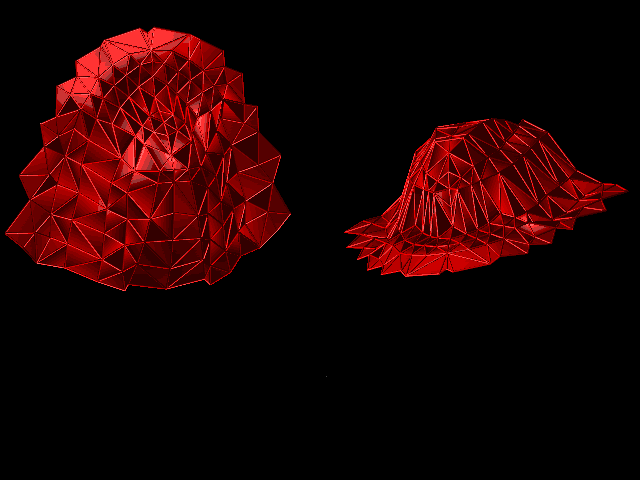
3D Wire Model Palate "Flying Palates"
Sample Movies. Click icons to see movies.

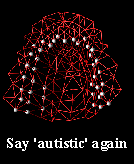
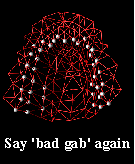
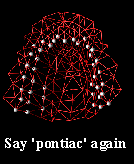


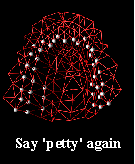

Back to physiology facilities
Back to general facilities
Back to Phonetics Lab Homepage
IV. Domain-initial strengthening : French and Korean
Keating et al (1998, LabPhon 6) and many other studies supported by NSF grant #SBR 9511118 (to P. Keating) showed, in their EPG studies of English, French, Korean, and Taiwanese, that consonants have greater linguopalatal contact in a domain-initial position than in a domain-medial position and that this effect is in general cumulative: the linguopalatal contact becomes greater as the domain is higher in the prosodic hierarchy. Such cumulative effect was more pervasive in one language (e.g., Korean) than in another (e.g., English). Here, we put some results from French and Korean with representative EPG contact figures and sounds (.WAV format).
(1) French [Please scroll down to "examples."]
- Ui = Utterance-initial,
- IPi = Intonational Phrase-initial (= Ui-medial)
- APi = Accentual Phrase-initial (= IP-medial)
- Wi = Word-initial (= AP-medial)
- Si = Syllable-initial (= W-medial)

Figure 3. Differences in linguopalatal contact for [n] in French as a function of prosodic position.
Examples:
- As shown in Figure 3, the linguopalatal contact becomes progressively greater as the prosodic position moves up in the prosodic hierarchy, except that there is no substantial difference between Ui and IPi.
- Note also that each initial position of a prosodic domain is the medial position of the immediately higher prosodic domain (e.g., Si = Word-medial, Wi = AP-medial, etc.)
[n]s in bold are target segments which occur in different prosodic positions. Examine the corpus and click each sentence to hear the sound, as you wish. (The Speaker is C. Fougeron.)
See French references below.
- Ui Paul aime Tata. Nadia les protége en secret.
'Paul loves Tata. Nadia protects them in secret'
- IPi La pauvre Tata, Nadia et Paul n'arriveront que demain
'Poor Tata, Nadia and Paul will arrive only tomorrow'
- APi Tonton, Tata, Nadia et Paul arriveront demain.
'Tonton, Tata, Nadia and Paul will arrive tomorrow'
- Wi Paul et Tata-Nadia arriveront demain matin.
'Paul and Tata-Nadia will arrive tomorrow morning'- Si Tonton et Anabelle arriveront demain matin.
'Tonton and Anabelle will arrive tomorrow morning'(2) Korean
The figure below shows that the linguopalatal contact varies depending on prosodic position in the direction Ui > IPi > APi > Wi (Wi > Si). (Note: Wi vs. Si was examined separately.)
Examples:
[n]s in bold are target segments which occur in different prosodic positions.

Examine the corpus and click below to hear the sound, as you wish. (The voice is T. Cho.)
See Korean References below:
Back to physiology facilities
Back to general facilities
Back to Phonetics Lab Homepage
V. Some References of EPG studies done at UCLA
Byrd, D. (1995) C-Center revisited. Phonetica, 52, 285-306
Byrd, D. (1996) Influences on articulatory timing in consonant sequences. Journal of Phonetics, 24, 209-244.
Byrd, D. (1996) A phase window framework for articulatory timing. Phonology,13(2):139-169.
Byrd, D. & C. C. Tan. (1996) Saying consonant clusters quickly. Journal of Phonetics, 24(2):263-282.
Byrd, D, E. Flemming, C. A. Mueller, & C. C. Tan. (1995) Using regions and indices in EPG data reduction. Journal of Speech and Hearing Research, 38:821-827.
Cho, T. (1998) Intergestural timing and overlap in Korean palatalization. In David Silva (eds.) Japanese/Korean Linguistic, vol. 8. CSLI: Stanford University.
Cho, T. (1998) Domain-initial strengthening in the prosodic hierarchy: an EPG study. Proceedings of 11th International Conference on Korean Linguistics (ICKL 11), July 6-9, 1998. University of Hawaii at Manoa.
Cho, T. and P. Keating (1999) Articulatory and acoustic studies of domain-initial strengthening in Korean. J. Phonetics 28:155-190 (2001)
Fougeron, C. (1999) Articulatory properties of initial segments in several prosodic constituents in French. Journal of Phonetics, Vol. 29, No. 2, Apr 2001, pp. 109-135.
Fougeron, C. & Keating, P. (1997) Articulatory strengthening at edges of prosodic domains. JASA, 106 (6), 3728 - 3740.
Fougeron, C. & Keating, P. (1996) : Variations in velic and lingual articulation depending on prosodic position: Results for 2 French speakers", UCLA Working Papers in Phonetics 92: 88-96 (1996)
Fougeron, C. & Keating, P. (1996) Articulatory strengthening in prosodic domain-initial position. UCLA Working Papers in Phonetics, 92, 61-87.
Hayashi, W; Hsu, C; Keating, P. (1999) Domain-initial strengthening in Taiwanese: A follow-up study. UCLA Working Papers in Phonetics, 97, 152-157.
Hsu, C. & Jun, S. (1998) Prosodic strengthening in Taiwanese: Syntagmatic or paradigmatic ? UCLA Working Papers in Phonetics, 96, 69-89.
Keating, P; Cho, T; Fougeron, C; Hsu, C. (1999) Domain-initial articulatory strengthening in four languages. UCLA Working Papers in Phonetics, 97, 139-151. (To appear in LabPhon 6)
Keating, P; Wright, R; Zhang, J. (1999) Word-level asymmetries in consonant articulation. UCLA Working Papers in Phonetics, 97, 152-157.
Saw, Cheng Cheng (1993) Customized 3-D Electropalatography Display. UCLA Working Papers in Phonetics, 85, 71-96.
Thomas, Kim. (1999) Coproduction and Coarticulation in IsiZulu
Clicks. PhD. dissertation. UCLA.
(her name is officially listed as Kimberly Diane Thomas-Vilakati)
Last updated: Oct. 2017 by P. Keating